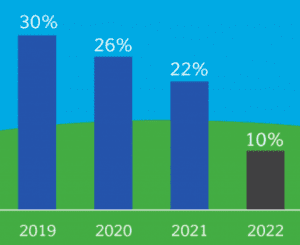As we cruise into 2019, like many industries, we like to review the solar in 2018. 2018 was chalk full of major changes and exciting solar developments, at home and abroad. Let’s review some of the solar industry highlights of the last year.
Renewal of the Tax Incentive

The federal ITC originally was established in 2005 (The Energy Policy Act) and was set to expire in 2007. However, through a series of extensions, including one this year, the ITC tax credit will continue to be available to consumers. The tax credit will remain at 30% through 2019. In 2020, commercial and residential solar buyers will have access to a 26% tax credit, which will drop to 22% in 2021. From 2022 on, owners of new commercial solar can take a 10% tax credit.
Rock Bottom Pricing
2018 can be characterized by rock bottom pricing on both residential and commercial solar installations. This can be traced back to the fact that the cost of solar panels is at a historical low. In early years of solar, consumers were paying $10 a watt of solar, which is more than twice as much as consumers pay today. Solar has become an incredibly affordable energy strategy for both business owners and homeowners.
Taxes and Tariffs
Another hot topic in 2018 was the 30% tariff President Trump placed on most imported solar panels and cells. The idea was it would drive more investment in U.S. solar manufacturing. Although there was fear the tariffs would cripple the solar industry. But, the implementation of the tariff happened to coincide with a global drop in demand (thanks to China) – which made solar panel prices to plummet. In fact, the cost of a solar panel today in many markets, with the 30% tariff is lower than a non-tariff panel at the beginning of the year.
Legislative Changes

Photo Credit: State of Oklahoma
We saw one of the biggest policy updates connected to solar in California in 2018. In early May, the California Energy Commission mandated that nearly all new homes have rooftop solar starting in 2020. Greentech Media predicts this will create a 14% increase in total U.S. solar sales over the next 4 years.
Another major legislative change is California’s commitment to source 50% of its electricity from renewables by 2030, and 100% by 2045. This means California has a lot of work over the next 25 years to ensure the California infrastructure can handle the transition to help California meet new energy goals.
A Year in Review

2018 has been an exciting year for the solar industry. What is often referred to as the “solar coaster” has been nothing but accurate in describing the year. To make sure you are part of the adventures that await in 2019, reach out to one of our Energy Advisers today and learn how solar can help you meet your energy and financial goals of the next year.
Here are some articles you may find helpful:
Top 10 Questions You Should Ask Any Solar Company
What are my Solar Finance Options?
Why are Solar Mounting and Racking Systems So Important
Do Solar Panels Add Value to My Home?


Leave a Reply